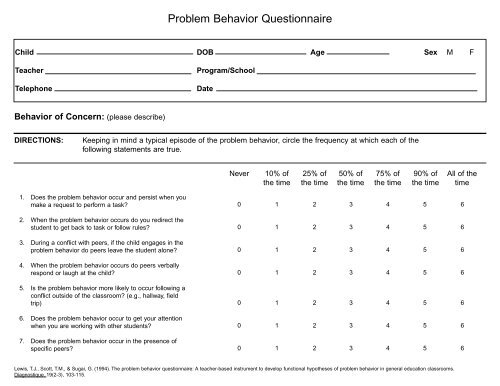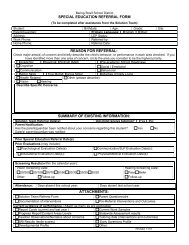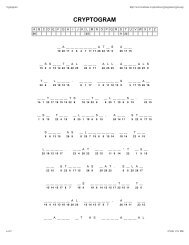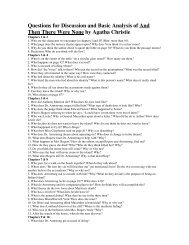Problem Behavior Questionnaire
Problem Behavior Questionnaire
Problem Behavior Questionnaire
You also want an ePaper? Increase the reach of your titles
YUMPU automatically turns print PDFs into web optimized ePapers that Google loves.
<strong>Problem</strong> <strong>Behavior</strong> <strong>Questionnaire</strong><br />
Child DOB Age Sex M F<br />
Teacher<br />
Telephone<br />
Program/School<br />
Date<br />
<strong>Behavior</strong> of Concern: (please describe)<br />
DIRECTIONS:<br />
Keeping in mind a typical episode of the problem behavior, circle the frequency at which each of the<br />
following statements are true.<br />
Never<br />
10% of<br />
the time<br />
25% of<br />
the time<br />
50% of<br />
the time<br />
75% of<br />
the time<br />
90% of<br />
the time<br />
All of the<br />
time<br />
1. Does the problem behavior occur and persist when you<br />
make a request to perform a task?<br />
0<br />
1<br />
2<br />
3<br />
4<br />
5<br />
6<br />
2. When the problem behavior occurs do you redirect the<br />
student to get back to task or follow rules?<br />
0<br />
1<br />
2<br />
3<br />
4<br />
5<br />
6<br />
3. During a conflict with peers, if the child engages in the<br />
problem behavior do peers leave the student alone?<br />
0<br />
1<br />
2<br />
3<br />
4<br />
5<br />
6<br />
4. When the problem behavior occurs do peers verbally<br />
respond or laugh at the child?<br />
0<br />
1<br />
2<br />
3<br />
4<br />
5<br />
6<br />
5. Is the problem behavior more likely to occur following a<br />
conflict outside of the classroom? (e.g., hallway, field<br />
trip)<br />
0<br />
1<br />
2<br />
3<br />
4<br />
5<br />
6<br />
6. Does the problem behavior occur to get your attention<br />
when you are working with other students?<br />
0<br />
1<br />
2<br />
3<br />
4<br />
5<br />
6<br />
7. Does the problem behavior occur in the presence of<br />
specific peers?<br />
0<br />
1<br />
2<br />
3<br />
4<br />
5<br />
6<br />
Lewis, T.J., Scott, T.M., & Sugai, G. (1994). The problem behavior questionnaire: A teacher-based instrument to develop functional hypotheses of problem behavior in general education classrooms.<br />
Diagnostique. 19(2-3), 103-115.
Never<br />
10% of<br />
the time<br />
25% of<br />
the time<br />
50% of<br />
the time<br />
75% of<br />
the time<br />
90% of<br />
the time<br />
All of the<br />
time<br />
8. Is the problem behavior more likely to continue to occur<br />
throughout the day following an earlier episode?<br />
0<br />
1<br />
2<br />
3<br />
4<br />
5<br />
6<br />
9. Does the problem behavior occur during specific<br />
activities?<br />
0<br />
1<br />
2<br />
3<br />
4<br />
5<br />
6<br />
10. Does the problem behavior stop when peers stop<br />
interacting with the child?<br />
0<br />
1<br />
2<br />
3<br />
4<br />
5<br />
6<br />
11. Does the behavior occur when peers are attending to<br />
other children?<br />
0<br />
1<br />
2<br />
3<br />
4<br />
5<br />
6<br />
12. If the child engages in the problem behavior do you<br />
provide 1–to–1 instruction to get child back on–task?<br />
0<br />
1<br />
2<br />
3<br />
4<br />
5<br />
6<br />
13. Will the child stop doing the problem behavior if you stop<br />
making requests or end an academic activity?<br />
0<br />
1<br />
2<br />
3<br />
4<br />
5<br />
6<br />
14. If the child engages in the problem behavior, do peers<br />
stop interacting with the child?<br />
0<br />
1<br />
2<br />
3<br />
4<br />
5<br />
6<br />
15. Is the problem behavior more likely to occur following<br />
unscheduled events or disruptions in routines?<br />
0<br />
1<br />
2<br />
3<br />
4<br />
5<br />
6<br />
<strong>Problem</strong> <strong>Behavior</strong> <strong>Questionnaire</strong> Profile<br />
DIRECTIONS:<br />
Circle the score given for each question from the scale below the corresponding question number (in bold):<br />
PEERS ADULTS SETTING EVENTS<br />
Escape<br />
Attention<br />
Escape<br />
Attention<br />
3 10 14<br />
6 6 6<br />
5 5 5<br />
4 4 4<br />
3 3 3<br />
2 2 2<br />
1 1 1<br />
0 0 0<br />
4 7 11<br />
6 6 6<br />
5 5 5<br />
4 4 4<br />
3 3 3<br />
2 2 2<br />
1 1 1<br />
0 0 0<br />
1 9 13<br />
6 6 6<br />
5 5 5<br />
4 4 4<br />
3 3 3<br />
2 2 2<br />
1 1 1<br />
0 0 0<br />
2 6 12<br />
6 6 6<br />
5 5 5<br />
4 4 4<br />
3 3 3<br />
2 2 2<br />
1 1 1<br />
0 0 0<br />
5 8 15<br />
6 6 6<br />
5 5 5<br />
4 4 4<br />
3 3 3<br />
2 2 2<br />
1 1 1<br />
0 0 0<br />
Lewis, T.J., Scott, T.M., & Sugai, G. (1994). The problem behavior questionnaire: A teacher-based instrument to develop functional hypotheses of problem behavior in general education classrooms.<br />
Diagnostique. 19(2-3), 103-115.
















